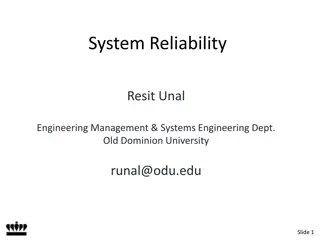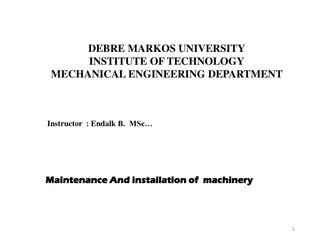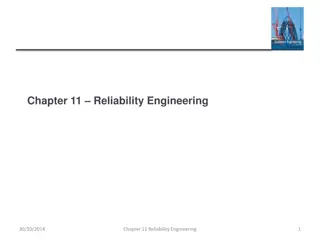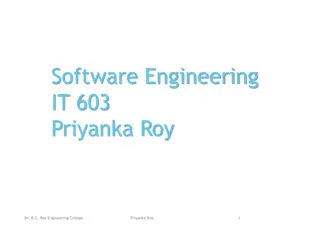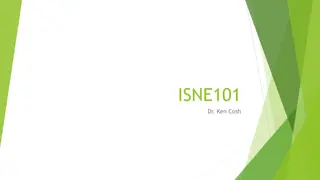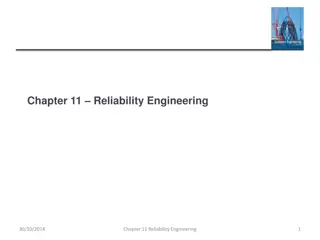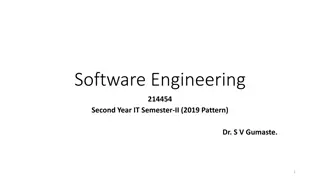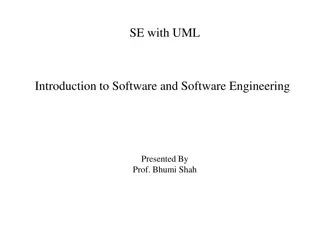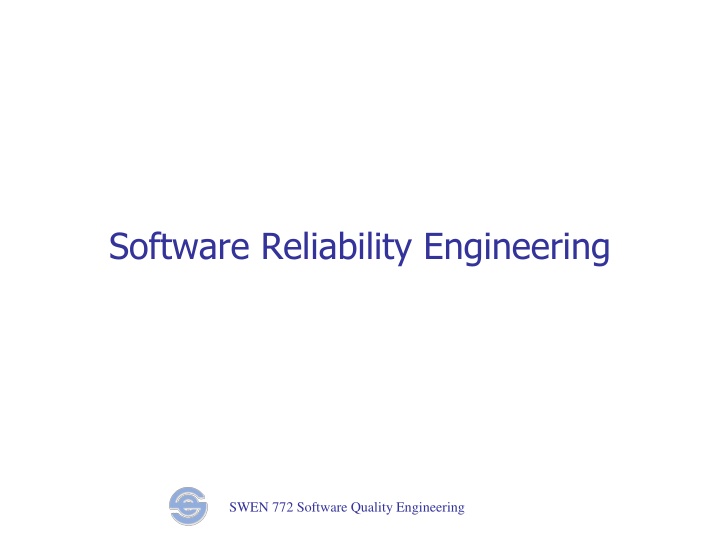
Software Reliability Engineering Overview
The key aspects of Software Reliability Engineering (SRE) including objectives, focus on reliability, engineering practices, establishing reliability objectives, and measuring reliability. Learn about setting quantitative targets for reliability to ensure business success."
Download Presentation

Please find below an Image/Link to download the presentation.
The content on the website is provided AS IS for your information and personal use only. It may not be sold, licensed, or shared on other websites without obtaining consent from the author. If you encounter any issues during the download, it is possible that the publisher has removed the file from their server.
You are allowed to download the files provided on this website for personal or commercial use, subject to the condition that they are used lawfully. All files are the property of their respective owners.
The content on the website is provided AS IS for your information and personal use only. It may not be sold, licensed, or shared on other websites without obtaining consent from the author.
E N D
Presentation Transcript
Software Reliability Engineering SWEN 772 Software Quality Engineering
Objectives Look at some details on Software Reliability Engineering (SRE) Steps in the SRE process Setting reliability objectives Using operational profiles to guide effort Interpreting reliability trend graphs SWEN 772 Software Quality Engineering
Reliability Focus Testing can only prove the presence of errors, not their absence. Dijkstra So, focus on reliability, not defects Correctness SWEN 772 Software Quality Engineering
Software Reliability Engineering Software Reliability Engineering (SRE) addresses the measurement, modeling, and improvement of software reliability Use quantitative information to choose the most cost-effective software reliability strategies for your situation SWEN 772 Software Quality Engineering
Reliability Engineering Practices Define reliability objectives Use operational profiles to guide test execution Track failures during system tests Use reliability growth curves to track quality of product Release when quality of product meets reliability objectives SWEN 772 Software Quality Engineering
Establish Reliability Objectives SRE Waterfall Engineer Just Right Reliability Develop Operational Profiles (OPs) Plan Tests Matched to OPs Predict software reliability growth Trade-offs between time, reliability, cost, performance, etc. When to stop testing release decision How much post-release support to plan for Use Test Results to Drive Decisions (Fielded System) Determine Achieved Reliability and OPs SWEN 772 Software Quality Engineering
Reliability and Failure Intensity Failure intensity: Number of failures per hour of operation Reliability is the inverse of failure intensity (FI) Reliability FI R Failure Intensity TIME SWEN 772 Software Quality Engineering
Defining Reliability Objectives Set quantitative targets for level of reliability that make business sense Impact of a failure FI Objective MTBF 100 s deaths, >$109 cost 1-2 deaths, around $106 cost $1,000 cost $100 cost $10 cost $1 cost 10-9 10-6 10-3 10-2 10-1 1 114,000yrs 114 yrs 6 weeks 100 h 10 h 1 h From John D. Musa SWEN 772 Software Quality Engineering
Operational Profiles Guide Effort Guide software development priorities and quality effort by what the user will use the most often Pareto principle: 20% of the software s functionality or size may satisfy 80% of the user s needs Operational profiles expose most frequently used product features SWEN 772 Software Quality Engineering
http://agile.csc.ncsu.edu/testing/SREChapter2.pdf SWEN 772 Software Quality Engineering
Testing Based on Operational Profiles Done during black-box system testing Mix of test cases that match operational profile If possible, create automated test harness to execute test cases Need to run large numbers of test cases with randomized parameters for statistical validity Execute test cases in randomized order, with selection patterns matching frequencies in operational profile Simulating actual pattern of usage SWEN 772 Software Quality Engineering
Studying Patterns in the Trends of Reliability Growth SWEN 772 Software Quality Engineering
Reliability Metric Estimated failure intensity (Reliability = 1 / failure intensity) Use reliability tracking and analysis tools to show actual (to date) and predicted (future) estimates of how failure intensity varies over time The curve is referred to as the reliability growth curve Note that the product being tested varies over time, with fixes and new code In-process feedback on how quality is changing over time SWEN 772 Software Quality Engineering
Code Integration/Build Patterns Most large projects have periodic builds Development team integrates a new chunk of code into the product and delivers to test team Test team does black box system testing Identifies defects (failures) and reports them to development team Track pattern of defects found during system testing to see how reliability varies as development progresses Defects found should decrease over time as defects are removed, but each new chunk of code adds more defects Pattern of reliability growth curve tells us about the code being added, and whether the product code is becoming more stable Pattern can also be used to statistically predict how much more testing will be needed before desired reliability target reached Useful predictions only after most of the code is integrated and failure rates trend downward SWEN 772 Software Quality Engineering
Tracking Failures During Testing Enter data about when failures occurred during system testing into reliability tool such as CASRE (Computer-Aided Software Reliability Engineering tool) or Statistical Modeling and Estimation of Reliability Functions for Software (SMERFS) Plots graph of failure intensity vs. development/test time Reliability In concept, a nice smooth curve of reliability growth FI R Failure Intensity TIME From netserver.cerc.wvu.edu/numsse/Fall2003/691D/lec3.ppt SWEN 772 Software Quality Engineering
Reliability Over Time Hardware Bathtub Model Software Model [DACS Software Reliability Source Book] SWEN 772 Software Quality Engineering
Predicting with a Software Reliability Growth Model [Rakitin] SWEN 772 Software Quality Engineering
A More Realistic Curve During Development From http://www.stsc.hill.af.mil/crosstalk/1996/06/Reliabil.asp SWEN 772 Software Quality Engineering
Many Statistical Models of Reliability Growth The Statistical Modeling and Estimation of Reliability Functions for Software (SMERFS) contains a collection of several reliability models, including: The Littlewood-Veral Bayesian model The Musa execution time model The geometric model The nonhomogeneous Poisson model for execution time data The Musa logarithmic Poisson execution time model The generalized Poisson model for interval data The nonhomogeneous Poisson model for interval data The Brooks-Motley discrete software reliability model The Schneidewind maximum likelihood model The Yamada S-shaped reliability growth model Get SMERFS at http://www.slingcode.com/smerfs/ SWEN 772 Software Quality Engineering
Model Comparison Using SMERFS^3 [Dolores R. Wallace Practical Software Reliability Modeling] SWEN 772 Software Quality Engineering
Interpreting Reliability Growth Curves Spikes are normally associated with new code being added Larger volumes of code or more unreliable code causes bigger spikes The curve itself tells us about the stability of the code base over time If small code changes/additions cause a big spike, the code is really poor quality or impacts many other modules heavily The code base is stabilizing when curve trends significantly downward Release (ideally) only when curve drops below target failure intensity objective indicates right time to stop testing Can statistically predict how much more test effort needed before target failure intensity objective needed SWEN 772 Software Quality Engineering
Limitations of Reliability Curves Operational profiles are often best guesses, especially for new software products The reliability models are empirical and only approximations Failure intensity objectives should really be different for different criticality levels of different kinds of failures Results in loss of statistical validity! Automating test execution is challenging (particularly building verifiers) and costly But it does save a lot over the long run More worthwhile when reliability needs are high Hard to read much from the growth curves till later stages of system testing very late in the development cycle SWEN 772 Software Quality Engineering
Reliability Certification Another use for reliability engineering is to determine the reliability of a received or acquired software product: Certification of Acceptability For example, you are evaluating web servers for your company website reliability is a major criterion Build a test suite representative of your likely usage Put up some pages, maybe including forms Create test suite that generates traffic Log failures such as not loading, wrong data received, server time out Track failure patterns over time Evaluate multiple products or new releases using test suite, to determine reliability Avoids major problems and delays with poor vendor software Note that this applies the analysis to a fixed code base Fewer problems with statistical validity SWEN 772 Software Quality Engineering
Example Certification Curve Run the product and track the time of occurrence of each failure Failure #1 Decision: Don t know enough yet, so continue running Failure #2 Decision: Don t know enough yet, so continue running Failure #3 Decision: Came far enough later (in MTBF sense) that the product is certified acceptable Had failures #3-7 happened as shown by the x s, then the failures are occurring too frequently -- Reject xxxx Based on http://www.stsc.hill.af.mil/crosstalk/1996/06/Reliabil.asp SWEN 772 Software Quality Engineering
Summary Software Reliability Engineering is a scientific (statistical) approach to reliability Vast improvement over common current practice Keep testing until all our test cases run and we feel reasonably confident Avoids under-engineering as well as over-engineering ( zero defects ) When done well, Software Reliability Engineering adds ~1% to project cost Musa s numbers: ~10% for medium-sized projects if you include cost of automated testing Note that as the number of builds and releases increases, automated testing more than pays for itself SWEN 772 Software Quality Engineering



